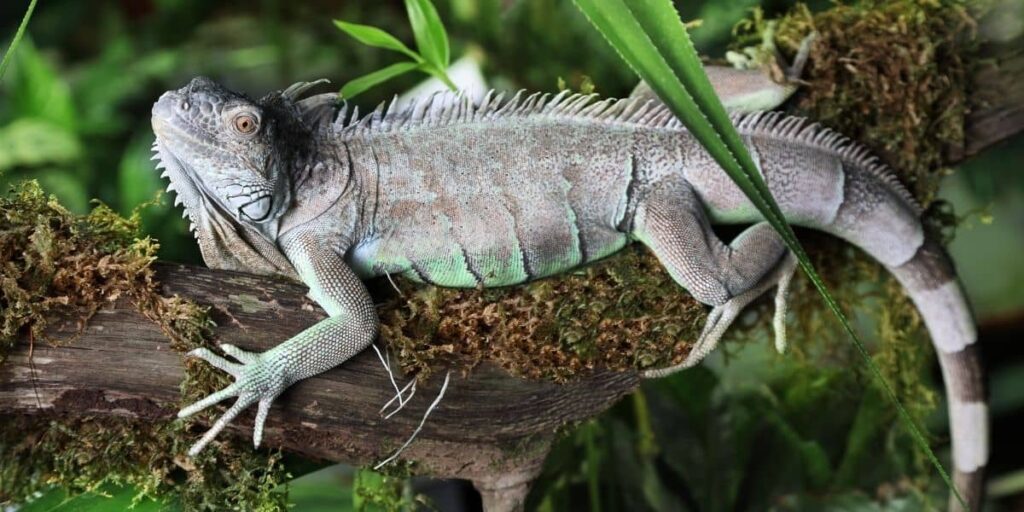There are many diverse types of lizards that can be adopted as a pet and most of these are relatively small. However, there are some breeds that can grow to an impressive size and for people who want a pet they can boast about, an iguana might be a viable choice.
These lizards can grow up to six feet in length when kept in captivity, so if you are planning to adopt one, you need to be prepared to provide it with suitable housing and plenty of exercises. In addition, you should think about the diet of this animal since, owing to its larger size, it will need something more substantial than a little gecko.
If you intend to become the proud owner of a beautiful iguana, then let us first congratulate you on your choice. Secondly, we should warn you that, in terms of size, there are many things to consider.
Are Iguanas Big?
One of the biggest myths about these reptiles is that they will only grow as big as their enclosure. But let us assure you that this could not be further from the truth.
The growth of your iguana certainly will not be stunted by keeping it in a smaller enclosure. All this will serve to do is upset your pet and prevent it from having the right amount of space for moving around comfortably.

Iguanas can grow up to six feet from the tip of the tail to the head and so will need to be kept in a decent-sized enclosure. Furthermore, these magnificent animals can weigh a significant amount when they are fully grown with some adults weighing in excess of 18lbs.
In short, if you’re going to be taking on one of these gentle giants, then be prepared to designate a decent portion of your living space for its enclosure.
Iguana Growth Chart
Many pet owners are astonished at how quickly their iguanas grow. While they may be relatively small when you first adopt them, it won’t take long before your lizard is almost as long as you are tall.
You might think that starting off with a smaller enclosure is a good idea, but you should always be prepared to upgrade as your baby iguana grows.
Below is a size chart according to the age of the iguana. Remember that this is an average guide, and your pet may be slightly bigger or smaller depending on factors such as health and diet.
| Age | Body Size in Inches | Body and Tail Size in Inches |
| Newborn | 2.36 | 5.91 – 7.87 |
| 3 months | 3.94 | 11.81 |
| 6 months | 5.91 | 17.72 |
| 1 year | 7.87 | 24.8 |
| 18 months | 9.84 | 29.92 |
| 2 years | 11.81 | 37.4 |
| 3 years | 15.75 | 45.28 |
| 4 years | 17.72 | 53.94 |
| 5 years | 19.69 | 59.84 |
More About Iguana Size
When we take on a pet, one of the first things that we want to know is how long the animal will live. If you’re looking for a temporary pet, then we would urge you to think twice before adopting an iguana. These animals can live up to 20 years in captivity when they are well cared for and so should be considered a long-term commitment.
In addition to this, you should think about the fact that, owing to its large size, an iguana will need a massive amount of space. At the very least, you will need to section off a substantial portion of a room for their housing, but many owners will dedicate an entire room to their pet which will give them maximum comfort and excellent quality of life. If you are able to do this, it is worth considering.
When looking at purchasing or making an enclosure for your iguana, you may be able to start off with something smaller as long as you are prepared to upgrade as your pet grows.
For babies up to around 18 inches, the cage should be at least 3ft in length. A good method for finding the right cage size is to double the length of the iguana. However, if you can provide more space, that is always preferable.
It is possible to allow your iguana to roam around the house, however, this should always be a supervised activity. This is because the iguana will climb and there is a risk of it falling and becoming injured.
Iguana Diet
In order for your iguana to reach its full adult size, it will need to be provided with the correct diet. It might be easy to assume, by looking at an iguana, that these are meat-eating creatures. But these friendly reptiles are, in fact, herbivores and so should never be offered the crickets or mealworms that you might offer other types of lizard.
It is entirely possible for an iguana to die quickly if it does not have a good diet, so it is important to provide this from the beginning. In the wild, iguanas will typically feed on foliage and leaves and this needs to be replicated in their captive diet.
Furthermore, owners should always keep in mind that the iguana will not chew its food but will simply put it in its mouth and swallow. For this reason, pieces of food should always be small and easy to swallow without presenting a choking hazard.
Conclusion
As far as pets go, iguanas might be one of the biggest. While they begin their life as tiny hatchlings that measure no more than about five inches to the tip of the tail, they can grow up to six feet in captivity.
It is, therefore, essential that iguanas are always given ample space and a healthy diet that will allow them to thrive for the long years that they live.




